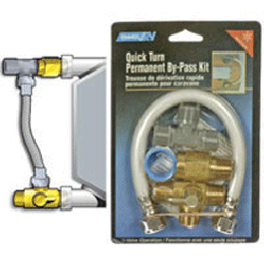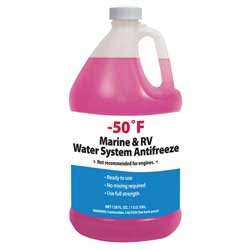If you aren’t a full-timer yet, you will probably need to Winterize the RV fresh water system. Winterizing can be a simple process, if you just follow the steps below. There are other ways to do this; I have given you the most common.
Water Heater Bypass Valve
If your rig does not have one, an important accessory to help Winterize the RV is a water heater by-pass. It is a simple device; one or two valves that isolate the tank from the rest of the water system. A water heater tank is normally about 7 gallons. If you do not have one of these, you will have to fill the tank with seven more gallons of expensive RV antifreeze than you need. Installation is a pretty simple do it yourself project, or any RV dealer can install it for you. You will save the cost of the valve in just a few years with the value of the antifreeze you save.

RV Antifreeze
RV antifreeze is safe to use in drinking water systems. Please do not use automotive antifreeze as it is poisonous and can cause serious illness and possibly death.

Procedure to Winterize the RV
So let’s get started. Here are the steps to Winterize the RV:
- Drain fresh water tank.
- Drain hot water heater.
- Dump and flush both black and gray water holding tanks, leave gray water valve open.
- Turn off fresh water supply
- Screw a compressed air adapter into the fresh water inlet. The adapter is available from Camping World or most RV dealers.
- Apply compressed air, keeping the pressure less than twenty pounds per square inch.
- Open each faucet, one valve at a time, allowing the compressed air to force the water out of the line. Don’t forget the shower and toilet.
- Remove the drain plug from the hot water tank and allow the compressed air to blow out the remaining water. Reinstall drain plug.
- Disconnect the compressed air and the adapter.
- Close the water heater by-pass valve.
- Remove the water line that runs between the fresh water pump and the fresh water tank, where it joins the fresh water tank. There is an inexpensive adapter kit to make this easy and it is available from most RV parts dealers.
- Insert the end of the line into a gallon jug of RV antifreeze. (Again, do NOT use automotive antifreeze.)
- Start the fresh water pump. It will run for a few moments, sucking antifreeze from the jug. It will stop as pressure in the system builds up.
- Open each valve of each faucet, one at a time, until the red antifreeze appears; then shut the faucet. Don’t forget the shower, toilet, and outside shower.
- Remove the line from the jug of antifreeze and reattach it to the inlet side of the water pump or close the valve if you have an adapter.
- Pour a cup or two of antifreeze into each drain including the shower.
You’re done!
